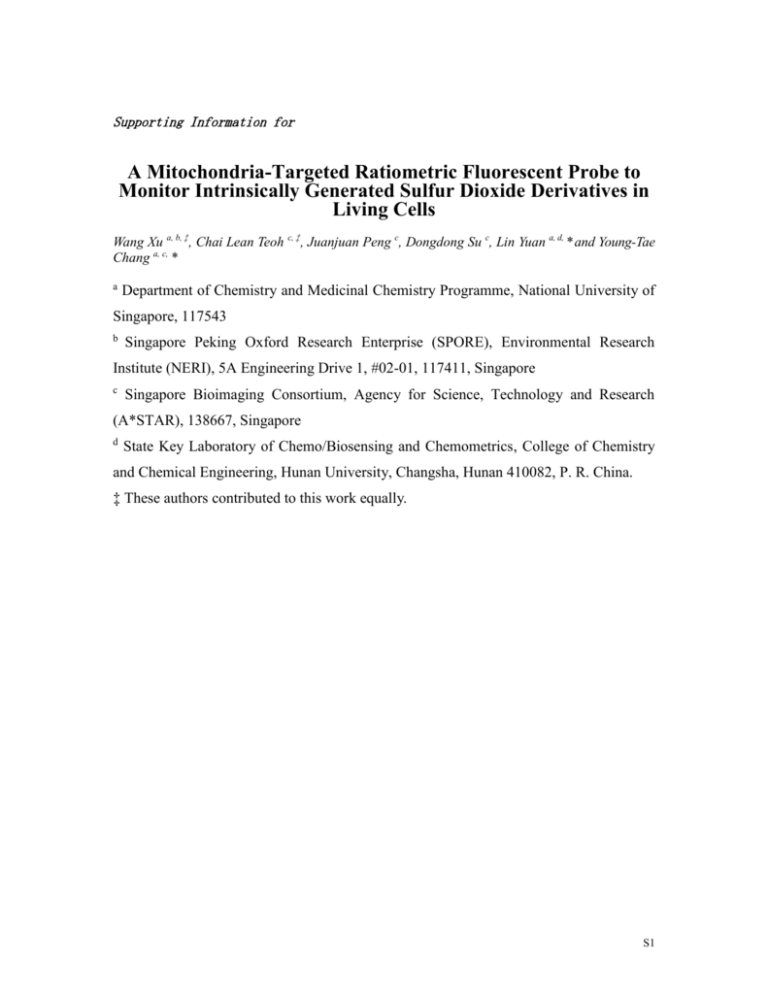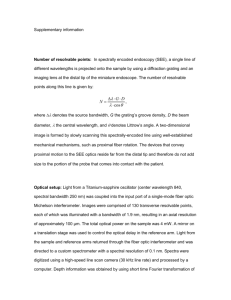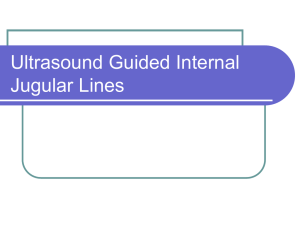SI - Young-Tae Chang - National University of Singapore
advertisement

Supporting Information for A Mitochondria-Targeted Ratiometric Fluorescent Probe to Monitor Intrinsically Generated Sulfur Dioxide Derivatives in Living Cells Wang Xu a, b, ‡, Chai Lean Teoh c, ‡, Juanjuan Peng c, Dongdong Su c, Lin Yuan a, d, * and Young-Tae Chang a, c, * a Department of Chemistry and Medicinal Chemistry Programme, National University of Singapore, 117543 b Singapore Peking Oxford Research Enterprise (SPORE), Environmental Research Institute (NERI), 5A Engineering Drive 1, #02-01, 117411, Singapore c Singapore Bioimaging Consortium, Agency for Science, Technology and Research (A*STAR), 138667, Singapore d State Key Laboratory of Chemo/Biosensing and Chemometrics, College of Chemistry and Chemical Engineering, Hunan University, Changsha, Hunan 410082, P. R. China. ‡ These authors contributed to this work equally. S1 Table of contents Synthesis …………………………………………………………….………………………. S3-4 Quantum yield calculation ………… ……………………………….………………………. S5 Detection limit calculation ………… ……………………………….………………………. S5 Table S1…………………………………………………………….……………….………...S6 Figure S1…………………………………………………………….……………….………..S10 Figure S2…………………………………………………………….……………….………..S10 Figure S3…………………………………………………………….……………….………..S11 Figure S4…………………………………………………………….……………….………..S11 Figure S5…………………………………………………………….……………….………..S12 Figure S6…………………………………………………………….……………….………..S12 Figure S7…………………………………………………………….……………….………..S13 Figure S8…………………………………………………………….……………….………..S14 Figure S9…………………………………………………………….……………….………..S15 Figure S10…………………………………………………………….……………….….…. .S16 Figure S11…………………………………………………………….………….…….…..….S16 Table S2-S4…………………………………………………………….………….…….…S17-18 Figure S12…………………………………………………………….…….………….……. .S19 Figure S13…………………………………………………………….….…………….…..….S20 Figure S14…………………………………………………………….….…………….…..….S20 The copy of NMR ………………………………………………….….…………………. S21-22 S2 Synthesis Compounds 1, 2, 3, 4 and 5 were prepared on the basis of a known procedure (Chem Commun, 2010, 46, 7930; Org. Lett. 2007, 9, 33; Chem. Mater. 1996, 8, 541). Compound 1 (Mito-Ratio-SO2) 1-methyl-2,3,3-trimethyl-3H-indolium iodide 3 (63.0 mg, 0.2 mmol) was treated with coumarin aldehydes 3 (49.1 mg, 0.2 mmol) in anhydrous ethanol (10 mL). The reaction mixture was then refluxed for 10 h, and the solvent was removed under reduced pressure. The resulting residue was purified by column chromatography on silica gel (CH2Cl2 to CH2Cl2 /acetone = 50: 1) to afford the compound 1 as a reddish brown powder (78.2 mg, yield: 72.1%). 1H NMR (500 MHz, CDCl3) δ 10.02 (s, 1H), 8.57 (d, J = 15.9 Hz, 1H), 8.04 (s, 1H), 8.02 (d, J = 6.3 Hz, 1H), 7.51 (dd, J = 14.6, 5.9 Hz, 3H), 7.47 (t, J = 7.1 Hz, 2H), 6.67 (dd, J = 9.0, 2.0 Hz, 1H), 6.43 (d, J = 1.9 Hz, 1H), 3.50 (dd, J = 14.2, 7.0 Hz, 4H), 1.81 (s, 6H), 1.32 (s, 3H), 1.26 (t, J = 7.1 Hz, 6H).; 13C NMR (126 MHz, CDCl3) δ 181.41, 162.89, 161.14, 158.87, 154.65, 150.92, 142.82, 141.71, 134.47, 129.49, 129.12, 122.64, 113.56, 112.78, 111.11, 109.26, 96.90, 51.75, 45.71, 29.99, 27.54, 12.70. HRMS (EI) m/z calcd for C26H29N2O2(M+): 401.2224. Found 401.2401. Compound 5 Compound 5 was prepared according to literature (Chem Commun, 2010, 46, 7930– 7932.). Compound 1 (75.0 mg, 0.14 mmol) was dissolved in ethanol (2 mL), and then NaBH4 (2.1 mg, 0.056 mmol in 0.5 mL ethanol) was added drop-wise over 10 min. Subsequently, the reaction mixture was stirred at room temperature for 30 min, and the solvent was removed under reduced pressure. The resulting residue was purified on a S3 silica gel column (CH2Cl2/petroleum ether = 3: 7) to afford compound 5 as a yellow powder (51.2 mg, yield: 87.9%). 1H NMR (400 MHz, CD3CN/CDCl3 = 4: 1) δ 1.04 (t, J = 7.2 Hz, 3H), 1.06 (s, 3H), 1.90 (t, J = 7.4 Hz, 6H), 1.29 (s, 3H), 3.07-3.15 (m, 1H), 3.27-3.35 (m, 1H), 3.44 (q, J = 7.2 Hz, 4H), 3.69, 3.72 (1H), 6.49 (d, J = 8.0 Hz, 1H), 6.51 (s, 1H), 6.54 (d, J = 8.8 Hz, 1H), 6.59 (s, 1H), 6.63-6.68 (2H), 7.01 (d, J = 6.4 Hz, 1H), 7.04 (t, J = 7.6, 1.2 Hz, 1H), 7.35 (d, J = 8.8 Hz, 1H), 7.77 (s, 1H); 13C NMR (100 MHz, CD3CN/CDCl3 = 4: 1) δ 8.88, 11.09, 22.89, 24.57, 28.54, 38.60, 43.24, 43.62, 95.66, 106.37, 107.68, 108.40, 115.55, 120.83, 126.49, 127.25, 128.21, 128.28, 138.11, 138.27, 148.71, 149.84, 154.83, 160.39; HRMS (EI) m/z calcd for C 27H32N2O2 (M): 416.2458. Found 416.2435. S4 Quantum yield calculation Quantum yields were determined using rhodamine B (0.70 in MeOH) as a standard according to a published method (Velapoldi, R. A.; Tønnesen, H. H. J. Fluoresc. 2004, 14, 465). The quantum yield was calculated according to the equation: Φsample = Φstandard × (AstandardFsample/AsampleFstandard) where Φsample and Φstandard are the fluorescence quantum yield of the sample and the standard, respectively; Fsample and Fstandard are the integrated fluorescence intensities of the sample and the standard spectra, respectively; Asample and Astandard are the optical densities at the excitation wavelength, of the sample and the standard, respectively. Quantum yield of probe Mito-Ratio-SO2: Φ = 0.11. After the complete reaction with sulfite, the Quantum yield of adduct: Φ = 0.09. Detection limit calculation The detection limit was calculated based on the fluorescence titration (Joshi,B. P.; Park, J.; Lee, W. I.; Lee, K. Talanta. 2009, 78, 903; Wu, M. Y.; Li, K.; Hou, J.T.; Huang, Z.; Yu, X. Q. Org. Biomol. Chem. 2012, 10, 8342). Probe Mito-Ratio-SO2 was employed at 5 μM. To determine the S/N ratio, the emission intensity of Mito-Ratio-SO2 without sulfite was measured by 20 times and the standard deviation of blank measurements was determined. Under the present conditions, a good linear relationship between the emission ratios (I480/I650) and the sulfite concentration could be obtained in the 0.3-50 μM (R = 0.999), as shown in Figure S2. The detection limit is then calculated with the equation: detection limit = 3σ/m, where σ is the standard deviation of blank measurements, m is the slope between the emission ratios versus sample concentration. The detection limit was measured to be 0.09 μM at S/N = 3 (signal-to-noise ratio of 3:1). S5 Table S1. Summary of fluorescent probes for SO2 derivatives ID Probe Name 1 Anthracene chemodosimeter 1[1] 2 Coumarin probe 3d[2] ex/nma em/nmb 290 380 353/417 458 Detection Limit/M 780 Detection Medium Interaction Mechanismc SO32detection Model 90% water/DMSO solution (pH 7.2, 10 mM Tris -HCl buffer) FRET --- ESIPT HSO3detection in granulated sugar 0.37 pH 5.0 (NaH2PO4/Na2HPO4) 3 Resorufin probe 1[3] 487 588 49 HEPES buffered (pH 7.0, 10 mM) H2OCH3CN (98:2, v/v) 4 BODIPY-Le[4] 538 570/647 58 H2O/DMSO solution (1:1) 5 Benzimidazol probe 1[5] 325 368/498 0.4 6 Rhodamine B probe 1[6] 510 580 0.89 7 Anthracene probe[7] 370 420 0.01 8 Benzothiazol probe 1[8] 310 373/468 5 9 DEACA[9] 390 483 0.187 446 480/578 34 410 465/592 0.2 10 11 Coumarin probe 1[10] TSP[11] Deprotection of levulinate moiety and ESIPT Deprotection of levulinate moiety and ESIPT --- --- 20% v/v ethanol– water solution ICT buffered at pH 4.6 NaAc-HAc Water–ethanol Ring (90/10, v/v) at pH opening of 4.8 Na2HPO4–citric spiroacid buffer rhodamine pH 7.0 HEPES aqueous solution PET containing DMSO (2%, v/v) HEPES buffered (pH Deprotection 7.4, 10 mM) of levulinate H2O/CH3CN (50%, moiety and v/v) ESIPT 0.2 M Na2HPO4 citric acid (pH 5.0 ESIPT aqueous buffer) 20% DMF buffer ICT solution CTAB–20 mM PBS, ICT --- --- --- --- ----SO32S6 pH 7.4, 25 ◦C 12 N1[12] 355 460 4 13 Coumarin hemicyanine dye 1[13] 445 478/633 0.38 14 SP-2[14] 405 600 0.24 15 P-1[15] 330 395/515 2 350 460 0.39 216 phenylisothiazolo probe 1[16] 17 Coumarin-TCF probe 2[17] 18 Naphthalimide probe 1[18] 19 Coumarin probe 1[19] 20 BIFS[20] 21 Benzopyrylium probe 1[21] 22 466/580 520/660 430 448 530 585 322/470 460/595 420 0.00027 0.56 0.00083 0.0003 495/690 0.00104 Coumarin– indolium probe 1[22] 450/550 485/667 0.0027 23 Coumarin– benzopyrylium probe 1[23] 430/605 485/640 0.0034 24 Mito-Ratio-SO2 (Current Work) 405 480/650 0.09 detection in mineral water, sugar and white wine Buffered (HEPES 30 mm, pH 7.5) ESIPT suspensions PBS buffer (pH 7.4, 10 mM, containing ICT 30% DMF) DMSO : HEPES buffer (3 : 7, 10 mM, MLCT pH 7.5) THF/H2O = 3/7, pH ICT 5.0 Disruption THF/water solution (1/999, v/v) buffered of by 20 mM HEPES at structure and pH 7.2 AIE 20 mM pH 7.4 HEPES buffer ICT solution 10 mM PBS buffer (pH 7.2–7.4): DMSO ICT = 9:1(v/v) pH 7.4 HEPES buffer (20.0 mM) Glycerol/PBS solution = 4/6, pH 7.40 HEPES buffer (20.0 mM, pH ¼ 7.4, containing 2% DMF) MeOH–PBS buffer (20 mM, pH 7.4, 1: 1, v/v) Phosphate buffer (pH 7.4, 20 mM, containing 0.25% ethanol as a cosolvent) pH 7.4 PBS (containing 15% --HeLa cells HepG2 cells HeLa cells --- U-2OS cells GES-1 cells PET A431 cells and HepG2 cells TICT A549 cells PET HeLa cells ICT Paper strip test and HeLa cells PET HepG2 cells ICT Mitochondria in HeLa cells S7 EtOH as a cosolvent) a excitation wavelength (nm) of the probe. “/” indicates two excitation wavelengths for one probe. b emission wavelength (nm) of the probe. “/” indicates ratiometric fluorescence change excited by either excitation or two excitation wavelengths. c FRET: Förster resonance energy transfer; ESIPT: Excited-state intramolecular proton transfer; ICT: Intramolecular charge transfer; PET: Photo-induced electron transfer; MLCT: metalto-ligand charge transfer; AIE: Aggregation-induced emission. References: [1] Sun YM, Zhong C, Gong R, Mu HL, Fu EQ. A Ratiometric Fluorescent Chemodosimeter with Selective Recognition for Sulfite in Aqueous Solution. J Org Chem. 2009;74:7943-6. [2] Chen KY, Guo Y, Lu ZH, Yang BQ, Shi Z. Novel Coumarin-based Fluorescent Probe for Selective Detection of Bisulfite Anion in Water. Chinese J Chem. 2010;28:55-60. [3] Choi MG, Hwang J, Eor S, Chang SK. Chromogenic and Fluorogenic Signaling of Sulfite by Selective Deprotection of Resorufin Levulinate. Org Lett. 2010;12:5624-7. [4] Gu XF, Liu CH, Zhu YC, Zhu YZ. A Boron-dipyrromethene-Based Fluorescent Probe for Colorimetric and Ratiometric Detection of Sulfite. J Agr Food Chem. 2011;59:11935-9. [5] Wang G, Qi HP, Yang XF. A ratiometric fluorescent probe for bisulphite anion, employing intramolecular charge transfer. Luminescence. 2013;28:97-101. [6] Yang XF, Zhao ML, Wang G. A rhodamine-based fluorescent probe selective for bisulfite anion in aqueous ethanol media. Sensor Actuat B-Chem. 2011;152:8-13. [7] Yu CM, Luo M, Zeng F, Wu SZ. A fast-responding fluorescent turn-on sensor for sensitive and selective detection of sulfite anions. Anal Methods-Uk. 2012;4:2638-40. [8] Chen S, Hou P, Wang JX, Song XZ. A highly sulfite-selective ratiometric fluorescent probe based on ESIPT. Rsc Adv. 2012;2:10869-73. [9] Yang YT, Huo FJ, Zhang JJ, Xie ZH, Chao JB, Yin CX, et al. A novel coumarin-based fluorescent probe for selective detection of bissulfite anions in water and sugar samples. Sensor Actuat B-Chem. 2012;166:665-70. [10] Wu MY, He T, Li K, Wu MB, Huang Z, Yu XQ. A real-time colorimetric and ratiometric fluorescent probe for sulfite. The Analyst. 2013;138:3018-25. [11] Tian H, Qian J, Sun Q, Bai H, Zhang W. Colorimetric and ratiometric fluorescent detection of sulfite in water via cationic surfactant-promoted addition of sulfite to alpha,beta-unsaturated ketone. Analytica chimica acta. 2013;788:165-70. [12] Santos-Figueroa LE, Gimenez C, Agostini A, Aznar E, Marcos MD, Sancenon F, et al. Selective and Sensitive Chromofluorogenic Detection of the Sulfite Anion in Water Using Hydrophobic Hybrid OrganicInorganic Silica Nanoparticles. Angew Chem Int Edit. 2013;52:13712-6. [13] Sun YQ, Liu J, Zhang J, Yang T, Guo W. Fluorescent probe for biological gas SO2 derivatives bisulfite and sulfite. Chem Commun (Camb). 2013;49:2637-9. [14] Li GY, Chen Y, Wang JQ, Lin Q, Zhao J, Ji LN, et al. A dinuclear iridium(III) complex as a visual specific phosphorescent probe for endogenous sulphite and bisulphite in living cells. Chem Sci. 2013;4:4426-33. [15] Cheng XH, Jia HZ, Feng J, Qin JG, Li Z. "Reactive" probe for hydrogen sulfite: Good ratiometric response and bioimaging application. Sensor Actuat B-Chem. 2013;184:274-80. [16] Yang BC, Niu XY, Huang ZX, Zhao CH, Liu Y, Ma C. A novel kind of dimmer (excimer)-induced-AIE compound 2-phenylisothiazolo[5,4-b]pyridin-3(2H)-one as high selective bisulfite anion probe. Tetrahedron. 2013;69:8250-4. [17] Wu MY, Li K, Li CY, Hou JT, Yu XQ. A water-soluble near-infrared probe for colorimetric and ratiometric sensing of SO2 derivatives in living cells. Chem Commun (Camb). 2014;50:183-5. [18] Wang CC, Feng S, Wu LY, Yan SY, Zhong C, Guo P, et al. A new fluorescent turn-on probe for highly sensitive and selective detection of sulfite and bisulfite. Sensor Actuat B-Chem. 2014;190:792-9. [19] Chen W, Fang Q, Yang D, Zhang H, Song X, Foley J. Selective, highly sensitive fluorescent probe for S8 the detection of sulfur dioxide derivatives in aqueous and biological environments. Analytical chemistry. 2015;87:609-16. [20] Zhu L, Xu J, Sun Z, Fu B, Qin C, Zeng L, et al. A twisted intramolecular charge transfer probe for rapid and specific detection of trace biological SO2 derivatives and bio-imaging applications. Chem Commun. 2015. [21] Chen W, Liu X, Chen S, Song X, Kang J. A real-time colorimetric and ratiometric fluorescent probe for rapid detection of SO2 derivatives in living cells based on a near-infrared benzopyrylium dye. Rsc Adv. 2015;5:25409-15. [22] Zhang Q, Zhang Y, Ding S, Zhang H, Feng G. A near-infrared fluorescent probe for rapid, colorimetric and ratiometric detection of bisulfite in food, serum, and living cells. Sensor Actuat B-Chem. 2015;211:377-84. [23] Chen Y, Wang X, Yang X-F, Zhong Y, Li Z, Li H. Development of a ratiometric fluorescent probe for sulfite based on a coumarin–benzopyrylium platform. Sensor Actuat B-Chem. 2015;206:268-75. S9 Fl. intensity (a.u.) 5000 4000 3000 2000 1000 0 600 700 800 Wavelength, nm Figure S1. Fluorescence spectral changes of Mito-Ratio-SO2 (5 μM) upon addition of sulfite (0-25 equiv.). The spectra were recorded after incubation of the probe with sulfite for 30 min. λex = 572 nm. Figure S2. Plot of fluorescent ratio (I480/I650) of the probe Mito-Ratio-SO2 as a function of sulfite concentration. S10 Figure S3. Emission spectral changes of Mito-Ratio-SO2 (5 μM) with time upon addition of sulfite (100 equiv.) in pH 7.4 PBS (containing 15% EtOH as a co-solvent). λex = 572 nm. Absorption 0.45 0.30 0.15 0.00 400 500 600 700 Wavelength, nm Figure S4. Absorption spectral changes of Mito-Ratio-SO2 (5 μM) with time upon addition of sulfite (100 equiv.) in pH 7.4 PBS (containing 15% EtOH as co-solvent): 0 min (■), 0.5 min (★), 1 min (●), 1.5 min (▲), 2 min(★), 3 min (□). S11 Figure S5. Pseudo first-order kinetic plot of Mito-Ratio-SO2 (5 μM) reaction with sulfite (100 equiv.) in pH 7.4 PBS (containing 15% EtOH as co-solvent). Slope = -0.012 s-1. Fl.intensity (a. u.) 120 80 40 0 500 600 700 Wavelength, nm Figure S6. Time-dependent (0-40 min) emission spectra of Mito-Ratio-SO2 (5 μM) + SO2 donor (200 μM) upon addition of 1 mM Cys in pH 7.4 PBS (containing 15% EtOH as co-solvent). S12 Figure S7. Fluorescence emission ratio (I480/I650) of probe Mito-Ratio-SO2 (5 μM) in the absence (▲) and presence (■) of sulfite (25 equiv.) under different pH conditions. S13 Figure S8. The ESI-MS of probe Mito-Ratio-SO2 (top) and probe with sulfite (bottom) in pH 7.4 PBS (containing 15% EtOH as co-solvent). 401.2: Probe 1; 481.1: [1-SO3]-. S14 Figure S9. Job plots for Mito-Ratio-SO2 and sulfite interaction with a total concentration of [Mito-Ratio-SO2] + [sulfite] at 40 μM by fluorescence response. The fluorescence emission at 480 nm was used. S15 Figure S10. DFT optimized structure of Mito-Ratio-SO2, adduct c and adduct b. In the ball-and-stick representation, carbon, nitrogen, oxygen, and sulphur atoms are colored in gray, blue, red, and yellow, respectively. The purple color refers to sodium atom. The calculation was performed using Gaussian 09 (Revision A.02). Figure S11. Frontier molecular orbital plots of Mito-Ratio-SO2, adduct c and adduct b in water (CPCM model). The calculation was performed using Gaussian 09 (Revision A.02). S16 Table S2. The frontier molecular orbitals (MOs) of Mito-Ratio-SO2. Frontier Orbital Energy Level Orbital Conformation LUMO + 1 -1.98eV LUMO -3.28eV HOMO -5.86eV HOMO - 1 -6.87eV Table S3. The frontier molecular orbitals (MOs) of adduct b. Frontier Orbital Energy Level Orbital Conformation LUMO + 1 -0.59eV LUMO -1.95eV S17 HOMO -5.15eV HOMO - 1 -5.59eV Table S4. The frontier molecular orbitals (MOs) of adduct c. Frontier Orbital Energy Level Orbital Conformation LUMO + 1 -0.74eV LUMO -2.07eV HOMO -5.33eV HOMO - 1 -5.51eV S18 Figure S12. The absorbance and ESI-MS of probe Mito-Ratio-SO2 (top) and probe with sulfite (bottom three rows) in pH 7.4 PBS (containing 15% EtOH as co-solvent). Adduct a is least abundant with lowest absorbance intensity detected. Adduct b is non fluorescent with shortest absorbance wavelength. Adduct c is the fluorescent form with high abundance and long absorbance wavelength. 401.2: Probe 1; 481.1: [1-SO3]- / adduct a & b & c. S19 Figure S13. Cytotoxicity assay of probe Mito-Ratio-SO2 at different concentrations (a: 0 μΜ; b: 1 μΜ; c: 2 μΜ; d: 5 μΜ; e: 10 μΜ; f: 15 μΜ; g: 25 μΜ; h: 50 μΜ; i: 75 μΜ; j: 100 μΜ; k: 150 μΜ; l: 200 μΜ; m: 250 μΜ; n: 300 μΜ; o: 350 μΜ; p: 400 μΜ; q: 500 μΜ) for HeLa cells. LD50 for HeLa cells was calculated to be 93 μΜ. Figure S14. Fluorescence images of HeLa cells. Cells were incubated with 1 μM probe Mito-Ratio-SO2 and 200 nM LysoTracker Green or Hoechst 33258 at 37 °C for 20 min in DMEM media supplemented with 10% FBS: (a) and (e) probe Mito-Ratio-SO2 with excitation at 559 nm and a scan range of 600–700 nm; (b) LysoTracker Green with excitation at 488 nm and a scan range of 520–570 nm; (c) overlay of a and b; (d) Colocalization coefficient (Pearson's coefficient) of Mito-Ratio-SO2 and LysoTracker green is 0.72; (f) Hoechst 33258 with excitation at 460 nm and a scan range of 500–550 nm; (g) overlay of d and e; (h) Co-localization coefficient (Pearson's coefficient) of Mito-RatioSO2 and Hoechst33258 is 0.68. Scale bar: 50 μm. S20 S21 S22





![[sample] Focus Group & Individual Interview Guide](http://s3.studylib.net/store/data/006626260_1-52ac55bdb30beaa664c3c37fc5ba0cb1-300x300.png)

